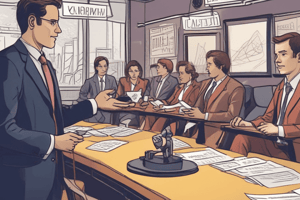Podcast
Questions and Answers
What is the primary purpose of effective communication?
What is the primary purpose of effective communication?
- To convey information and understanding (correct)
- To impress your audience
- To create confusion
- To entertain at all costs
Which of the following best describes barriers to communication?
Which of the following best describes barriers to communication?
- Factors that obstruct the transmission of information (correct)
- Methods that encourage interaction
- Elements that enhance understanding
- Tools that improve conversation flow
What role does feedback play in effective communication?
What role does feedback play in effective communication?
- It provides clarification and understanding (correct)
- It distracts from the main message
- It is irrelevant to the communication process
- It complicates the conversation
How can cultural differences affect communication?
How can cultural differences affect communication?
What is an essential skill for effective public speaking?
What is an essential skill for effective public speaking?
Flashcards
Empty Content
Empty Content
The provided content is completely blank.
No Instructions
No Instructions
No instructions or tasks are specified.
Formatting Only
Formatting Only
The content represents formatting, not information.
Large Whitespace
Large Whitespace
Signup and view all the flashcards
Lack of Data
Lack of Data
Signup and view all the flashcards
Study Notes
Book Title and Author
- Title: فنون الشرق الأوسط والعالم القديم
- Author: نعمت إسماعيل علام
Book Content Overview
- The book covers the art of the Middle East and ancient world, from the prehistoric period to the pre-Islamic era.
- It examines art forms in Egypt, Mesopotamia, Anatolia, Levant, and Iran.
- It includes images accompanying the text to aid comprehension of various artistic styles.
- The book aims to provide a comprehensive overview of the art of the Middle East in a single volume, avoiding the need for multiple references.
- It explores the relationship between political events and artistic development.
- The author discusses the influence of classical world art on the arts of other regions and vice versa.
- The book includes a chronological presentation of artifacts, and comparisons between them.
- The author expresses his gratitude to museums that provided imagery.
Prehistoric Period and Development of Art
- Prehistoric humans in the Middle East developed artistic expressions.
- Stone tools were used in the Paleolithic period.
- Bone and polished stone tools emerged in the Mesolithic period.
- Copper tools were introduced in the Neolithic period.
- Early humans transitioned from food gathering to food production.
- This led to settled communities and villages.
- Early artistic expression was initially in cave paintings, using pigments like iron oxides.
- These paintings primarily showcased animals.
- Some areas in the Middle East, such as the Nile Valley and Mesopotamia, developed civilizations at an accelerated rate.
- Prehistoric art forms demonstrate humans' early attempt to represent their world by drawing animals.
Egyptian Art in the Prehistoric Era
- Traces of Paleolithic and Mesolithic human presence were discovered.
- Early settlements were alongside river valleys as natural resources facilitated growth.
- Early settlements migrated from oases to river valley locations due to increased aridity.
- The Tassian culture (5000 BC) showcased early pottery and stone tools.
- The Badarian Culture (4000 BC) showed improved pottery skills and the use of copper tools.
- The Naqada culture (3400 BC) exhibited development in the production of statues, pottery decorated with animal/human motifs.
- Key artifacts from this era include pottery, figurines, and tools.
- Archaeological evidence from the Naqada period points to advanced technical and artistic mastery.
- The unification of Upper and Lower Egypt occurred around 4245 BC, with a capital in the center of the nation.
- The development of hieratic writings and pharaonic rule impacted artistic expression.
Mesopotamian Art in the Prehistoric Era
- The fertile crescent experienced settlements.
- The earliest civilizations in Mesopotamia emerged in Jarmo, Hassuna, and Molafat.
- These settlements date to the early 6th millennium BC and predate the later civilizations of Sumer, Samarra, Halaf, Uruk, and Jamdat Nasr,
- There was skilled pottery-making since the 5th millennium BC.
- Artifacts from Hassuna demonstrate early pottery traditions.
- Elaborate pottery, decorated with animal motifs, was indicative of advanced Mesopotamian pottery skills.
- The Ubaid period (mid-4th millennium BC.) saw advancements in pottery and architecture.
- Uruk period (late 4th millennium BC) saw the development of writing, cylinder seals, and significant advancements in urban planning.
- The Jemdet Nasr period (3000 BC), a transitional phase, showcases a decline in artistic sophistication and a shift toward writing on clay tablets.
Other Regions of the Ancient World
- The book discusses the development of art and culture in regions like Syria, Anatolia (Turkey), and Iran, showing how these cultures interacted and influenced each other.
- Excavations in Syria, Anatolia, and Iran provide insights into diverse artistic trends and local variations of art forms found in the Middle East.
- Archaeological discoveries reveal information about the evolution of local civilizations in the Middle East and their interactions.
Studying That Suits You
Use AI to generate personalized quizzes and flashcards to suit your learning preferences.




